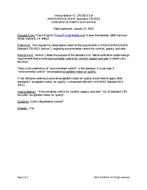According to ASHRAE Guideline GPC 14-2002 and the IPMVP option C, the baseline model is the crucial element for the savingsdetermination of a whole building. From both energy conservation and return on investment perspectives, it is necessary and essential to give theenergy savings under an accurate uncertainty, since the meaning and significance of the uncertainty of the measured energy savings could help toavoid erroneous conclusions or misconceptions about the validity of the savings that are being obtained in a building retrofit or commissioningproject.
The evaluation of the savings uncertainty may be affected by many factors through the whole project, but in a well monitored or metered buildingand as it was indicated previously the most important portion is the one that comes from the baseline model. This paper presents a brief statisticaldescription of the comprehensive analysis needed to evaluate uncertainty which is based on matrix algebra and illustrates the internal relationshipbetween these expressions and the simplified ones (Reddy and Claridge, 2000). Based on actual building utility data and the comprehensivestatistical expressions, the estimated savings uncertainties were compared to the ones from simplified expressions for different periods – number ofmonths or days – and their accuracy was analyzed. This paper also introduces an improved expression that accounts for the differences found fordifferent length of the period under analysis pursuing to improve the lack of accuracy on the simplified expressions.
Citation: ASHRAE Conference Papers, Denver, CO
Product Details
- Published:
- 2013
- Number of Pages:
- 8
- File Size:
- 1 file , 330 KB
- Product Code(s):
- D-DE-13-C033


